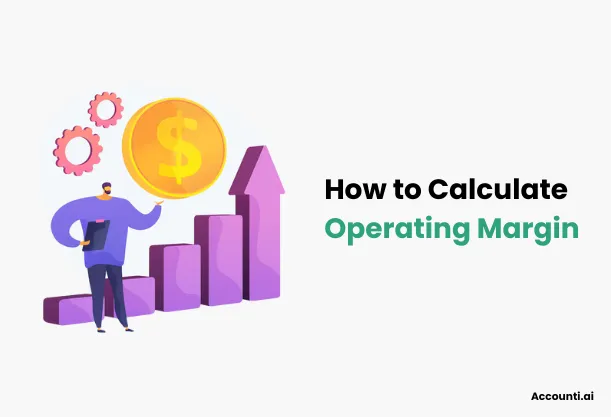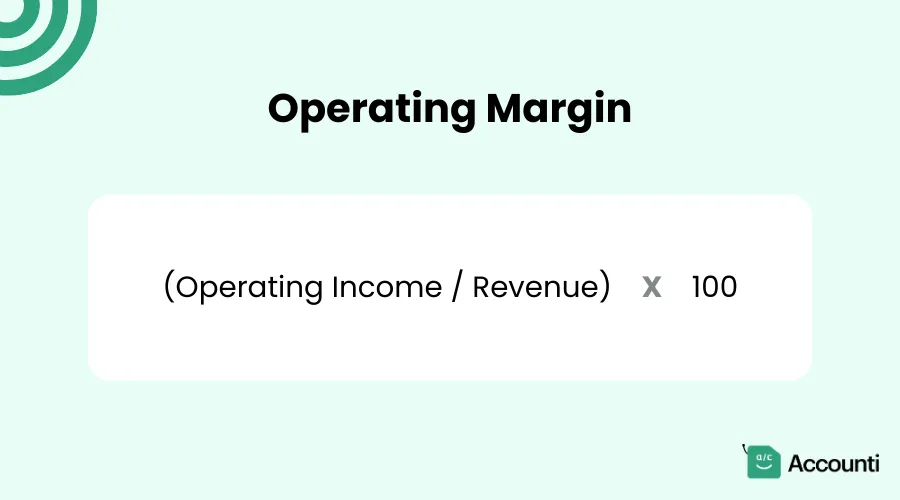
How to Calculate Operating Margin: The Essential Guide
One of the most important metrics for assessing a business's profitability and operational efficiency is the operating margin.
But what exactly is operating margin, and how do you calculate it? In this comprehensive guide, we'll walk you through everything you need to know about operating margin, from its definition to a step-by-step calculation process and real-world applications.
Have you ever wondered how efficiently your business is turning revenue into profit? That's where the operating margin comes in. It's a powerful financial metric that offers insights into a company's operational efficiency and profitability. Whether you're a business owner, investor, or financial analyst, understanding how to calculate and interpret operating margins is essential for making informed decisions.
In this article, we'll dive deep into the world of operating margin. We'll explore its definition, and importance, and provide you with a clear, step-by-step guide on how to calculate it. By the end of this guide, you'll be equipped with the knowledge to assess and improve your business's financial performance using this crucial metric.
What is Operating Margin?
Operating margin, simply put, is a measure of how much profit a company makes from its core business operations, relative to its total revenue. It's expressed as a percentage and tells us how efficiently a company is managing its operations.
But let's break it down further. Imagine you're running a lemonade stand. Your operating margin would tell you what percentage of money you're keeping from each glass of lemonade sold, after accounting for the cost of lemons, sugar, and your time spent making and selling the lemonade.
How it Differs from Other Profit Margins
You might be wondering, "Aren't there other types of profit margins?" Absolutely! Let's quickly compare operating margin to two other common profit margins:
- Gross Margin: This measures the profit left after subtracting the cost of goods sold (COGS) from revenue. It doesn't account for operating expenses like marketing or admin costs.
- Net Margin: This is the percentage of revenue left after all expenses, including taxes and interest, have been deducted. It's the "bottom line" profit margin.
Operating margin sits between these two. It's more comprehensive than gross margin but doesn't include non-operating expenses like interest and taxes, which net margin does.
Why Operating Margin is Crucial for Businesses
Now, you might be thinking, "Why should I care about operating margin?" Well, here's why it's a big deal:
- Operational Efficiency: It shows how well a company is managing its operations. A high operating margin indicates that a business is efficient at converting revenue into profit.
- Comparative Analysis: It allows for easy comparison between companies of different sizes within the same industry.
- Financial Health Indicator: A steady or improving operating margin over time is often a sign of good financial health.
- Decision-Making Tool: It helps in making crucial business decisions, from pricing strategies to cost management.
The Formula for Operating Margin
Ready to dive into the nitty-gritty? Here's the formula for operating margin:

Operating Margin = (Operating Income / Revenue) x 100
Simple, right? But don't be fooled by its simplicity. Understanding each component is key to accurate calculation and interpretation.
Explanation of Each Component
Let's break down the formula:
- Operating Income: Also known as operating profit, this is the profit a company makes from its core business operations. It's calculated by subtracting operating expenses from gross profit.
- Revenue: This is the total amount of money earned from selling goods or services before any expenses are deducted.
How to Derive Operating Income from Financial Statements
Finding operating income on a financial statement can be tricky if you're not familiar with accounting terminology. Here's a quick guide:
- Start with the income statement.
- Look for a line item called "Operating Income" or "Operating Profit."
- If it's not explicitly stated, you can calculate it:
- Find Gross Profit (Revenue - Cost of Goods Sold)
- Subtract Operating Expenses (like selling, general, and administrative expenses)
- The result is your Operating Income
Remember, operating income doesn't include things like interest expenses, taxes, or investment income.
Step-by-Step Guide to Calculating Operating Margin
Now that we understand the components, let's walk through the process of calculating operating margin, step by step.
Step 1: Obtain the Financial Statements
First things first, you need accurate financial data. This usually means getting your hands on the company's income statement.
Why is this important? Accurate data is the foundation of any financial analysis. Using outdated or incorrect information can lead to misleading results and poor decision-making.
Where to find the data: For public companies, you can usually find financial statements in their annual reports or SEC filings. For your own business, you'll want to refer to your most recent income statement.
Step 2: Identify Operating Income
Next, we need to find or calculate the operating income.
What operating income includes (and excludes):
- Includes: Revenue from core business operations
- Excludes: Interest income, investment gains, and other non-operating income
Adjustments that might be necessary:
- One-time expenses or gains should be excluded to get a more accurate picture of regular operations.
- Make sure to include all relevant operating expenses, such as depreciation and amortization.
Step 3: Determine Total Revenue
Now, let's identify the total revenue.
Different types of revenue to include:
- Sales revenue
- Service revenue
- Any other income from core business activities
Common mistakes to avoid:
- Don't include non-operating revenue, like interest income or proceeds from asset sales.
- Ensure you're using gross revenue, not net revenue (after returns or discounts).
Step 4: Apply the Formula
Now comes the fun part – putting it all together!
- Take your Operating Income
- Divide it by Total Revenue
- Multiply by 100 to get a percentage
Let's look at a real-world example:
Imagine a company, TechGadgets Inc., has the following financial data:
- Total Revenue: $1,000,000
- Operating Income: $200,000
Applying our formula:
Operating Margin = ($200,000 / $1,000,000) x 100 = 20%
TechGadgets Inc. has an operating margin of 20%, meaning it keeps $0.20 as operating profit for every dollar of revenue.
Why Operating Margin Matters
Now that we know how to calculate operating margin, let's explore why it's so important.
Importance in Business Decision-Making
Operating margin is a powerful tool for business leaders. Here's how it informs key decisions:
- Pricing Strategies: A low operating margin might indicate a need to raise prices or find ways to cut costs.
- Cost Management: It helps identify when operational costs are eating into profits too much.
- Expansion Decisions: A healthy operating margin can support decisions to expand or invest in new ventures.
Benchmarking and Comparisons
One of the most valuable aspects of operating margin is its use in comparisons:
- Industry Benchmarking: Compare your company's performance to industry averages.
- Competitor Analysis: See how you stack up against your main competitors.
- Historical Trends: Track your company's efficiency over time.
Indicators of Operational Efficiency
Operating margin is like a report card for your business operations:
- High Operating Margin: Indicates efficient management and strong competitive advantage.
- Low Operating Margin: Might signal operational inefficiencies or intense market competition.
- Changing Operating Margin: Can reveal the impact of new strategies or market conditions.
Common Mistakes and Pitfalls
Even seasoned professionals can make mistakes when working with operating margins. Let's explore some common pitfalls and how to avoid them.
Misinterpreting Operating Margin
It's easy to jump to conclusions when looking at operating margin. Here are some misconceptions to watch out for:
- Assuming Higher is Always Better: While a high operating margin is generally good, an unusually high margin might indicate underinvestment in the business.
- Ignoring Context: A "good" operating margin in one industry might be poor in another.
- Overlooking Trends: A single year's operating margin doesn't tell the whole story. Always look at trends over time.
Ignoring Industry Standards
Remember our lemonade stand? Well, its operating margin would look very different from that of a software company. Here's why industry context matters:
- Capital Intensity: Industries requiring heavy investment (like manufacturing) often have lower operating margins than service-based industries.
- Market Maturity: Younger markets might see higher margins due to less competition.
- Regulatory Environment: Some industries face regulations that impact their margins.
Always compare apples to apples. A 15% operating margin might be excellent in the grocery industry but mediocre in the software sector.
Overlooking Non-Operating Costs
While operating margin is a great metric, it doesn't tell the whole story. Here's what it misses:
- Interest Expenses: Especially important for companies with high debt.
- Taxes: Tax rates can vary significantly between companies and jurisdictions.
- One-Time Costs or Gains: These can skew operating margin for a particular period.
To get a complete picture of a company's profitability, always consider other metrics alongside operating margin, such as net profit margin.
Improving Your Operating Margin
Now that we understand how to calculate and interpret operating margin, let's explore strategies to improve it.
Strategies for Businesses
Improving operating margin often comes down to two main approaches: increasing revenue or decreasing costs. Here are some strategies:
- Optimize Pricing:
- Analyze your pricing strategy. Are you charging enough?
- Consider value-based pricing instead of cost-plus pricing.
- Improve Operational Efficiency:
- Streamline processes to reduce waste.
- Invest in technology to automate repetitive tasks.
- Manage Inventory Effectively:
- Implement just-in-time inventory systems to reduce storage costs.
- Negotiate better terms with suppliers.
- Control Labor Costs:
- Optimize staffing levels.
- Invest in training to improve productivity.
- Reduce Overhead:
- Review and renegotiate fixed costs like rent and utilities.
- Consider remote work options to reduce office space needs.
Revenue Growth Tactics
While cutting costs is important, growing revenue can have an even bigger impact on operating margin. Here are some tactics:
- Expand Product Lines:
- Introduce new products or services that complement your existing offerings.
- Look for opportunities to upsell or cross-sell to existing customers.
- Enter New Markets:
- Explore geographical expansion.
- Target new customer segments.
- Improve Marketing and Sales:
- Invest in targeted marketing campaigns.
- Train your sales team to improve conversion rates.
- Enhance Customer Retention:
- Implement loyalty programs.
- Improve customer service to increase repeat business.
- Consider Strategic Partnerships:
- Look for synergies with other businesses.
- Explore licensing or franchising opportunities.
Remember, the goal is to grow revenue faster than costs. This way, even as your business expands, your operating margin improves.
Real-World Examples
Let's bring our discussion to life with some real-world examples. We'll look at how different companies have managed their operating margins and what we can learn from them.
Case Study 1: A Tech Company
Let's consider the case of Apple Inc., a leader in the tech industry known for its high operating margins.
Situation: In fiscal year 2020, Apple reported:
- Revenue: $274.52 billion
- Operating Income: $66.29 billion
Calculation: Operating Margin = ($66.29 billion / $274.52 billion) x 100 = 24.15%
Analysis:
- Apple's high operating margin reflects its strong brand power, allowing it to command premium prices.
- The company's vertical integration strategy, controlling both hardware and software, contributes to operational efficiency.
- Apple's focus on high-margin services (like Apple Music and iCloud) alongside its hardware products helps maintain a strong operating margin.
Lesson: Differentiation and diversification into high-margin areas can significantly boost operating margin.
Case Study 2: A Retail Business
Now, let's look at Walmart, a retail giant known for its low-price strategy.
Situation: For the fiscal year 2021, Walmart reported:
- Revenue: $559.2 billion
- Operating Income: $22.55 billion
Calculation: Operating Margin = ($22.55 billion / $559.2 billion) x 100 = 4.03%
Analysis:
- Walmart's lower operating margin reflects its strategy of high volume, low-price sales.
- The company focuses on operational efficiency and cost control to maintain profitability despite lower margins.
- Walmart's massive scale allows it to negotiate better terms with suppliers, helping to improve its margin.
Lesson: Even with lower margins, efficient operations and high volume can lead to significant profits.
Lessons from Successful Companies
Looking at these and other successful companies, we can draw some key lessons:
- Know Your Strategy: Whether it's premium pricing like Apple or volume sales like Walmart, align your operations with your core strategy.
- Continuous Improvement: Successful companies constantly look for ways to improve efficiency and reduce costs.
- Diversification: Expanding into new product lines or services can help improve overall margins.
- Leverage Technology: Investing in technology can significantly improve operational efficiency and, consequently, operating margin.
- Focus on Customer Value: Companies that provide high value to customers, whether through quality (Apple) or affordability (Walmart), tend to maintain strong operating margins.
- Adapt to Market Changes: Successful companies are those that can adjust their strategies in response to market shifts, maintaining their operating margins even in challenging times.
Remember, while these examples provide valuable insights, every business is unique. The key is to understand your specific market, customers, and operational context when working to improve your operating margin.
Conclusion
As we wrap up our deep dive into operating margin, let's recap the key points we've covered:
- Definition: Operating margin is a crucial financial metric that measures how efficiently a company turns revenue into profit from its core operations.
- Calculation: The formula is simple - (Operating Income / Revenue) x 100. However, accurately identifying these components from financial statements is key.
- Importance: Operating margin provides insights into a company's operational efficiency, allows for comparisons across companies and industries, and informs critical business decisions.
- Interpretation: While a higher operating margin is generally better, it's essential to consider industry standards and company-specific factors when interpreting this metric.
- Improvement Strategies: Businesses can improve their operating margin by optimizing pricing, enhancing operational efficiency, controlling costs, and implementing revenue growth tactics.
- Real-World Application: As we saw with Apple and Walmart, different business models and strategies can lead to varying operating margins, each successful in its own right.
Understanding and regularly monitoring your operating margin is not just an academic exercise – it's a fundamental part of running a successful business. It provides a clear picture of your company's operational efficiency and profitability, guiding crucial decisions on pricing, cost management, and growth strategies.
Remember, while operating margin is a powerful metric, it's most effective when used alongside other financial indicators to get a comprehensive view of a company's financial health. Regular analysis of your operating margin, combined with industry benchmarking and trend analysis, can help you identify areas for improvement and drive your business toward greater profitability and success.
So, whether you're a business owner looking to optimize your operations, an investor evaluating potential opportunities, or a financial analyst providing valuable insights, mastering the calculation and interpretation of operating margin is an essential skill in your financial toolkit.
Keep calculating, keep analyzing, and keep improving. Your operating margin – and your business – will thank you for it!

 Rohit Kapoor
Rohit Kapoor

